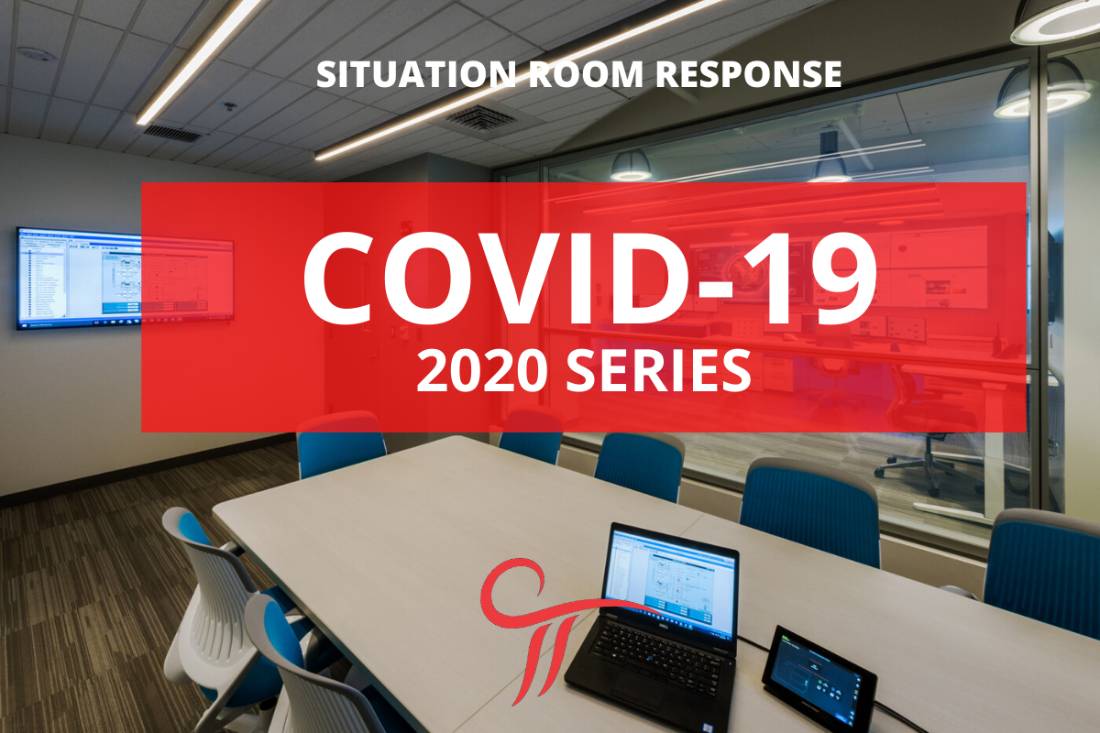As COVID-19 continues to spread globally, operations centers are hard at work. Critical in global monitoring and response, command centers including those in hospitals, local emergency operations centers, and even cyber security and social media have a role to play in handling pandemics. Join us as we begin this series exploring how each type of mission critical center is responding to the current situation.
Data Monitoring: The Response to COVID-19
Over the past several weeks, we have been discussing how various mission critical environments are responding to COVID-19. In this blog, we touch on the proliferation of data monitoring for the pandemic, which displays on video walls across all types of operations centers.
Monitoring COVID Data Across Organizations
As society navigates the COVID-19, data monitoring has become a critical element of tracking the pandemic.
Universities, public health agencies, and organizations around the world have been hard at work mining data and presenting it in digestible formats.
Data about COVID-19 is crucial to all types of organizations, not just those in the healthcare sector. Because the pandemic and its response affect so many facets of life and business, keeping an eye on data through video wall monitoring is important to all kinds of organizations.
As the United States and other countries continue to monitor and respond to the COVID-19 pandemic, there is a proliferation of data available. Tables, graphics, and projections are all over the internet and the news. Used the right way, this data can be used to interpret how best to combat the pandemic and how we as a society can continue to move forward in spite of it.
Projection Data
While no projection can truly predict the future, models based off policy changes, current growth and death rates, historical data, and informed assumptions can provide useful insights on what the coming days may look like.
Projection models can help inform decision-makers who need to craft surge response plans or allocate resources based on when it is expected to hit hardest in their area. It also allows policy makers in both public and private organizations to decide upon the best path forward to handle the pandemic.
COVID-19 Economic Data
The state of public health and economic health are closely connected. While quarantines and lockdowns have already created challenges for the economy, data about the current state of affairs and predicted further effects on the economy are useful for both business owners and policy-makers to plan their next steps forward.
Data Accessibility
The urgent nature of the pandemic has fueled the growing trend for “open science,” which is the movement to make data and other research-inputs publicly available so that other researchers can use the data for verification and expansion of findings.
Mark Musen, a Stanford professor of medicine and biomedical data science, is working alongside others to make data on COVID-19 accessible and reusable. Much of this effort involves creating good metadata and standardizing variable points. “Multiple organizations are using Stanford-developed technology like the web-based CEDAR Workbench to improve available COVID data.”
Efforts such as the COVID tracking project are making important data on the pandemic widely available. Many news sites have used this data to provide helpful visualizations of the data. This open sharing of data allows decision-makers of all scopes to have access to monitor actionable data that affects the public – and their organizations.
Video Walls and Data Monitoring
Whether they’re large scale and wall-to-wall or a simple large format 4K display, video walls are a key tool for data monitoring. Central video walls allow operators in any number of mission critical spaces to have a clear view of pertinent data in real-time.
The goal for any operations center video wall is to give operators all the information they need at hand to monitor, assess, and respond to critical events. Video walls display a growing amount of information in a quickly accessible, user-friendly format.
Constant’s Operations Centers
Moments of crisis often remind us how invaluable the multiple types of operations centers involved in emergency response can be. It’s important that emergency operations centers, medical command centers, and social media monitoring centers be up-to-date in order to provide efficient, reliable response. If your mission critical environment hasn’t been updated in several years, the technology may not be as reliable as it should be for round-the-clock use in a crisis situation.
Should your mission critical operations center be in need of a refresh, Constant is here to provide video wall integration, console furniture, project management, and service to ensure your center is best equipped to serve the public good.
The team at Constant is continuing to manage projects and support our clients through these uncertain times. If you would like to discuss your command center requirements, our expert team is here to help.
Stay Tuned
We are continuing to monitor the situation with COVID-19 and the responses aided by various types of command centers. Continue to check back as we explore these responses in the coming days with the continuation of our coronavirus series.
We began our series with a look into how emergency operations centers are responding to the outbreak and the increased responsibilities placed on cybersecurity operations centers. Most recently we took a dive into the world of digital monitoring. and healthcare command centers.
About Constant:
Constant Technologies, Inc. provides AV integration for 24/7 video walls and custom operation center furniture. With 30+ years of experience, we can work with sensitive environments in the public and private sectors. Constant designs and installs projects of all scopes and sizes around the world. We also offer long-term service and support. We create solutions with the highest levels of security, aesthetics and functionality in mind.

